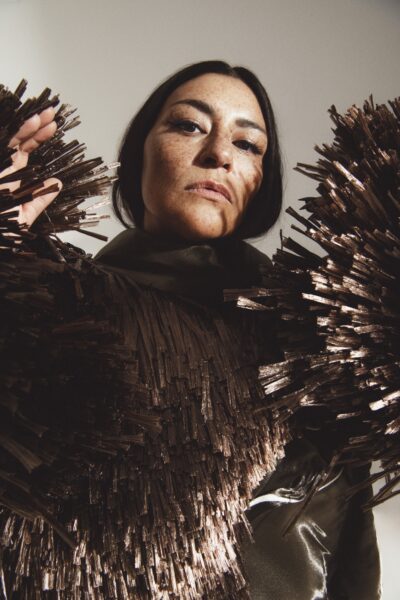“There is a whole world out there that can be about us”, Elisapie Qupanuaq Lissie Akumaliik Isaac, known as Elisapie (ᐃᓕᓴᐱ), says during our conversation about her new recording Inuktitut (ᐃᓄᒃᑎᑐᑦ). The Salluit-born and raised artist is now based in Montreal (Tio’tia:ke) from where she connects to the Zoom call. The new album is a collection of classic rock and pop songs that the Inuk artist translated and adapted into the Inuktitut language and culture. Simply titled Inuktitut, Elisapie’s music is a connector of worlds, a reclamation, a reappropriation of popular culture, and a gift to her community.


After having written in the colonial languages of English and French on previous releases, Elisapie is using this fourth album to write exclusively in Inuktitut. It is the language of the community in Nunavik, the northern part of the nation-state of Canada on Turtle Island. The experience of rewriting the songs that were an escape to her as a child and teenager has been moving. The singer has a personal connection to the songs, like many members of her community, where music has always played a central role as either traditional songs or pop songs translated into Inuktitut.
Elisapie decided to only include songs that make her emotional rather than songs she deemed especially political or cool. The outcome is a record that seeps with nostalgia in all of its pain and joy. Qimatsilunga ( ᕿᒪᑦᓯᓗᖓ) or I Want To Break Free, for example, is dedicated to her cousin Tayara who died by suicide and Elisapie turned the song into a stripped-back ballad. She remembers moments when music became a place of refuge.
“I realized that loving the music was about more than admiration. It was also about the violence that happened the night before, when my aunt and uncle had too much to drink, and their kids ran away to my house. I think music can be a relief and an escape. Music helps to deal with trauma.”
Most of the songs that were brought to the north, to Salluit, were pop and rock music by white artists. Elisapie has a deep love for bands like Metallica, whose music is present across arctic regions as she noticed when visiting Siberia. But of course, the images of the musicians – ABBA, Cyndi Lauper, Blondie – propagate white colonial beauty standards and Elisapie vividly remembers the effect that those had. “I remember my cousin and me daydreaming about being blonde and wanting to look and be like them.”
Emotional Archeology
Through the experience of motherhood and the backbone of her previous releases like the album The Ballad of A Runaway Girl, which reconnects to the nomadic roots of her community, Elisapie got to a point where she was able to become truly vulnerable in her search for identity and pride in it. Revisiting musical memories from good and bad days and translating songs with special meaning from English to Inuktitut, the artist embarked on an “archaeological and emotional trip”.
The linguistic structures of Inuktitut differ from English. Elisapie explains that a whole phrase can be expressed in one long word. I Want to Break Free becomes Qimatsilunga (ᕿᒪᑦᓯᓗᖓ) and Wish You Were Here becomes Qaisimalaurittuq (ᙯᓯᒪᓚᐅᕆᑦᑐᖅ). But it is not just about language, the singer clarifies. “There is something very rich and very real in my blood. In the process, I had to rethink how I see Inuktitut. It is more than just a language or a cultural reference. It is a way of life.”
Acknowledging the Pain
The story of the album is one that cannot be told without speaking about the history and ongoing violence of colonialism that affected Elisapie’s community as well. “When rock ‘n roll arrived in the 60s and 70s, my uncles had to go South – that means to the residential schools. Our grandparents were told that their kids needed to be educated to be a part of Canada. So, I think all this pain and trauma of colonization and residential schools is connected to the music they listened to back then.”
Elisapie’s artistic life centers this attachment and love for the community, the culture, and the land. She walks in the footsteps of thousand-year-old traditions of ways of life and expression that remain practiced until today. The record opens with Isumagijunnaitaungituq (ᐃᓱᒪᒋᔪᓐᓀᖏᑦᑕᖅ) or The Unforgiven and the backbone of the song is the warm and raspy hum of vibrating vocal cords in traditional throat singing practice also called Katajjaq. The song recounts the story of how “in the 1950s, the Canadian government ordered all the sled dogs in our tiny Inuit town of Salluit to be killed due to a few rabies cases. It was a devastating loss for our community, and for my father, whose traditional way of life and source of pride was gone”.
During our conversation, Elisapie does not claim the record to be a direct reappropriation of white rock and pop music, she rather highlights the importance of its linguistic resistance to colonial languages and its emotional connection. “I think, we are finally beginning to acknowledge, first just acknowledge, our pain. That is the state we are in. As a community, we are not even near healing. Many people are still in the state of not even realizing what happened in the last 60 years. It was such a short time ago, here in the North. The environment, the weather, and our world in the North made us who we are. Then suddenly to be taken off our lands, robbed of the connection to the land, the animals and to be forced to live in a way that is not in tune with the environment – that is a huge, huge violence.”
Letting in the Joy
Music and art have been used as tools against violence and as ways to solidarize, organize, and heal. Inuktitut does that by centering joyful and nostalgic childhood memories. Elisapie translates the songs that shaped a generation into the language that belongs to her and her community. This act also showcases the homogenic and exclusive nature of the music industry, which is predominantly white and cis male. So, Inuktitut is not a passive record that celebrates popular music of white artists. It is a creative work composed by an artist with a deep love for Inuktitut tradition and that imprints on each one of the songs. A rebellion against the colonial structures of the music industry, while honoring the songs that held her.
“By remembering our childhood, we are going to remember not just the beauty of it, but also the trauma. We want to dance and cry at the same time and that’s okay.”
Carrying Responsibility

Photo by Leeor Wild
Storytelling through song is something that is present in many cultures, Inuktitut among them. Ayaya tradition, for example, is a way of telling stories of battles between people in a very dramatic yet hypnotic way, as the singer puts it. At the intersection of tradition and popular music, does Elisapie then feel increased responsibility to tell the stories of her community and to continue oral and musical traditions?
She laughs and says: “I don’t like the word responsibility because I am a bit of a rebel. I don’t want to feel the responsibility, what I am trying to be is responsible for being true to myself so that I cannot mislead anybody.” Yet, by being her authentic self, Elisapie’s life also tells the stories of the people before her. She remembers her experience as a young person looking up to the elders in the community. In that sense, there is the responsibility of putting out songs with thought-out messages, like being outspoken about the increased violence and discrimination that women and girls face. “In my storytelling, there is never just one thing. There is a lot of action, but the rhythm is natural because I want to respect the rhythm of where we come from and the way we see things. I don’t want to just tell stories because we have to do it, I also want to challenge the way in which we tell those stories.”
Working with Tradition
Inuktitut breaks open the way stories are told by using an emotional translation and interpretation as a basis for new stories. It also incorporates old stories, the ancient traditions, like on Californiamut (ᑳᓕᕘᓂᐊᒧᑦ) or Going to California where the rhythmic hum of the throat singing or Katajjaq and the traditional Qilaut drum shapes the dynamic of the song. “My town is traditional and very close to the Ayaya chanting and also throat singing between two women. It was a women’s world in the way that they were throat singing and imitating the land and the animals. I think women have that power. We are healers and fighters.”
In the recording process, Elisapie worked with Sylvia Cloutier, an artist and friend who is from Nunavik as well. “She great throat singer”, Elisapie smiles. “We wanted to experiment a little bit and it turned into a beat that felt free. So, the throat singing became a kind of canvas for the arrangement of the song.”
Connecting Generations
During our conversation, Elisapie talked with eagerness. These are stories she wants to tell. They are her personal stories from crying and crying-laughing as a youngster together with her cousins, to the severe violence of colonialism that continues to cause suffering in the local communities and on the land – not just in the North of Turtle Island but all across the world. Art and music are tools to reconnect with the wisdom of ancestors. So, she is especially excited to introduce the elders to Metallica, Blondie, Cyndi Lauper, and other friends who helped her deal with the complexities of life and emotions as a teenager.
“The elders are the most important people there. We will have chairs for them at every concert. They will hear the songs that their children would listen to and that they never understood. I hope they can also see that there is a whole world out there that can be related to us, be addressed to us, and even be about us. I think it will create a bigger world. The elders have gone through so much trying to maintain a way of life. When we talk about a gap, it is often about young people adapting to traditions. But in this case, I want to talk about how we can integrate our elders into the worlds that we move in. I think this is important – to connect generations within the community.”
Inuktitut is out now via Bonsound.



